Influence of Surface Waviness of Journal and Bearing Bush on the Static Characteristics of Hydrodynamic Bearing
Abstract
:1. Introduction
2. Theoretical Analysis
2.1. Oil Film Thickness
2.2. Finite Difference Method
2.3. Boundary Conditions
2.4. Static Characteristics Parameters
2.4.1. Dimensionless Load Capacity and Attitude Angle
2.4.2. Dimensionless End Leakage Flow Rate
2.4.3. Frictional Coefficient
3. Solution Procedure
4. Results and Discussion
4.1. With Surface Waviness Only on the Journal or the Bearing Bush
4.2. Effect of the Combined Waviness Phase Angle
4.2.1. Influence on Dimensionless Load Capacity
4.2.2. Influence on Dimensionless End Leakage Flow Rate
4.2.3. Influence on the Friction Coefficient
4.2.4. Influence on the Altitude Angle
4.3. Effect of the Waviness Number
4.4. Effect of the Waviness Amplitude
5. Conclusions
- Journal bearings with waviness on the bearing bush may deteriorate or enhance the bearing characteristics, depending on the phase angle. A large waviness amplitude and small waviness number can further enhance the bearing characteristics. Such characteristics can be used to design bearings with high performance;
- In the case of combined or sole presence of surface waviness on the journal or bearing bush, the gap geometry near the attitude angle caused by the waviness of the journal and bearing bush greatly contributes to the pressure generated and hence determines the bearing performance;
- In the case of combining the journal and bearing bush surface waviness with the growth of the wave number, the maximum values of , , and will decrease while the minimum values will increase, and the bearing characteristics tend to be stable. With the growth of the wave amplitude ratio and the decrease of the wave number, the bearing characteristics will be greatly influenced, and the range of change of , , and becomes larger;
- The bearing with surface waviness on the journal thus generates periodic variations in its characteristics, due to the alteration of . Regarding the trajectory of the journal’s center, it would present periodic motion due to the change in load capacity, which may be a factor that causes a whirling action. As such, when the journal has a small waviness number, the journal’s center equilibrium position () generates large periodic variations and damages the bearing’s stability. In order to improve the stability of the journal bearing, the waviness amplitude ratio of the journal should be controlled, and a small waviness number should be avoided;
- The investigation in this paper presents initial research. Subsequent studies will expand on it with other surface irregularities and 3D journal and bearing bush morphologies. The research results indicate that the effect of surface waviness on the bearing system needs further discussion, and the dynamic and transient characteristics should be investigated.
Author Contributions
Funding
Institutional Review Board Statement
Informed Consent Statement
Data Availability Statement
Conflicts of Interest
Nomenclature
| the bearing clearance (m) | |
| oil film thickness (m) | |
| rotational speed (r/min) | |
| oil film pressure (N/m) | |
| , | journal and bearing center |
| dynamic viscosity of oil (Ns/m2) | |
| , | circumferential and axial coordinates |
| axial length of the bearing (m) | |
| diameter of the journal (m) | |
| oil film pressure matrices | |
| dimensionless oil film thickness | |
| iteration number | |
| eccentricity (m) | |
| journal radius (m) | |
| eccentricity ratio () | |
| attitude angle (rad) | |
| frictional coefficient | |
| , | coordinates () |
| linear velocity of the journal (m/s) | |
| frictional force (N) | |
| oil film thickness matrices | |
| , | load capacity in the X and Z directions |
| , | grid number in circumferential and axial coordinates |
| , | waviness numbers of the journal and bearing bush |
| waviness amplitude of the journal and bearing (m) | |
| , | load capacity () |
| dimensionless oil film pressure () | |
| dimensionless end leakage flow rate () | |
| , | angles of the start and end of the hydrodynamic film (rad) |
| ,,,,, | coefficient matrices |
| , | journal and bearing bush surface waviness amplitude ratio |
References
- Wilson, D. The effect of geometry variations on hydrodynamic bearing performance. ASLE Trans. 1966, 9, 411–419. [Google Scholar] [CrossRef]
- Mokhtar, M.; Aly, W.; Shawki, G. Computer-aided study of journal bearings with undulating surfaces. ASME J. Tribol. 1984, 106, 468–472. [Google Scholar] [CrossRef]
- Mokhtar, M.; Aly, W.; Shawki, G. Experimental study of journal bearings with undulating journal surfaces. Tribol. Int. 1984, 17, 19–24. [Google Scholar] [CrossRef]
- Chennabasavan, T.; Raman, R. The effects of geometric irregularities of journals on the performance of porous bearings. Proc. Inst. Mech. Eng. Part J J. Eng. Tribol. 1994, 208, 141–145. [Google Scholar] [CrossRef]
- Sharma, S.; Rajput, A. Effect of geometric imperfect ions of journal on the performance of micro polar lubricated 4-pocket hybrid journal bearing. Tribol. Int. 2013, 60, 156–168. [Google Scholar] [CrossRef]
- Rajput, A.; Sharma, S. A study of capillary compensated geometrically imperfect six pocket hybrid journal bearing of various geometric shapes of recess. Proc. Inst. Mech. Eng. Part J J. Eng. Tribol. 2014, 228, 170–186. [Google Scholar] [CrossRef]
- Rajput, A.; Sharma, S. Combined influence of geometric imperfections and misalignment of journal on the performance of four pocket hybrid journal bearing. Tribol. Int. 2016, 97, 59–70. [Google Scholar] [CrossRef]
- Rajput, A.; Yadav, S.; Sharma, S. Effect of geometrical irregularities on the performance of a misaligned hybrid journal bearing compensated with membrane restrictor. Tribol. Int. 2017, 115, 619–627. [Google Scholar] [CrossRef]
- Dimofte, F. Wave journal bearing with compressible lubricant–part I: The wave bearing concept and a comparison to the plain circular bearing. Tribol. Trans. 1995, 38, 153–160. [Google Scholar] [CrossRef]
- Dimofte, F. Wave journal bearing with compressible lubricant–part Ⅱ: A comparison of the wave bearing with a wave-groove bearing and a lobe bearing. Tribol. Trans. 1995, 38, 364–372. [Google Scholar] [CrossRef]
- Lin, T. Steady state performance of finite hydrodynamic journal bearing with three-dimensional irregularities. Wear 1994, 176, 95–102. [Google Scholar]
- Lin, T. The effects of three-dimensional irregularities on the performance characteristics of turbulent journal bearing. Wear 1996, 196, 126–132. [Google Scholar] [CrossRef]
- Van, O.; Beek, A.; Ros, M. A parametric study of the hydro-support. Tribol. Int. 2004, 37, 617–625. [Google Scholar]
- Kwan, Y.; Post, J. A tolerancing procedure for inherently compensated, rectangular aerostatic thrust bearings. Tribol. Int. 2000, 33, 581–585. [Google Scholar] [CrossRef]
- Rahmatabadi, A.; Nekoeimehr, M.; Rashidi, R. Micropolar lubricant effects on the performance of noncircular lobed bearings. Tribol. Int. 2010, 43, 404–413. [Google Scholar] [CrossRef]
- Rasheed, H. Effect of surface waviness on the hydrodynamic lubrication of a plain cylindrical sliding element bearing. Wear 1998, 223, 1–6. [Google Scholar] [CrossRef]
- Pang, X.; Chen, J.; Hussain, S. Study on optimization of the circumferential and axial wavy geometrical conFigureuration of hydrodynamic journal bearing. J. Mech. Sci. Technol. 2013, 27, 3693–3701. [Google Scholar] [CrossRef]
- Wang, X.; Xu, Q.; Wang, B.; Zhang, L.; Yang, H.; Peng, Z. Effect of surface waviness on the static performance of aerostatic journal bearings. Tribol. Int. 2016, 103, 394–405. [Google Scholar] [CrossRef]
- Zmarzły, P. Influence of the internal clearance of ball bearings on the vibration level. Eng. Mech. 2018, 2018, 961–964. [Google Scholar]
- Phalle, V.; Sharma, S.; Jain, S. Influence of wear on the performance of a 2-lobe multirecess hybrid journal bearing system compensated with membrane restrictor. Tribol. Int. 2011, 44, 380–395. [Google Scholar] [CrossRef]
- Sharma, S.; Phalle, V.; Jain, S. Performance of a noncircular 2-lobe multirecess hydrostatic journal bearing with wear. Ind. Lubr. Tribol. 2012, 64, 171–181. [Google Scholar] [CrossRef]
- Sharma, S.; Phalle, V.; Jain, S. Combined influence of wear and misalignment of journal on the performance analysis of three-lobe three-pocket hybrid journal bearing compensated with capillary restrictor. J. Tribol. 2012, 134, 72–81. [Google Scholar] [CrossRef]
- Pawar, S.; Phalle, V. Effect of wear on the performance of hole-entry hybrid conical journal bearing employing constant flow valve compensation. Proc. Inst. Mech. Eng. Part J J. Eng. Tribol. 2019, 233, 1277–1292. [Google Scholar] [CrossRef]
- Li, S.; An, Q. Lubrication performance of planar thrust bearing with consideration of roughness of the surfaces. Proc. Inst. Mech. Eng. Part J J. Eng. Tribol. 2018, 233, 1046–1058. [Google Scholar] [CrossRef]
- Adamczak, S.; Zmarzły, P. Research of the influence of the 2D and 3D surface roughness parameters of bearing raceways on the vibration level. J. Phys. Conf. Ser. 2019, 1183, 012001. [Google Scholar] [CrossRef]
- Li, D.; Yang, X.; Lu, C.; Cheng, J.; Wang, S.; Wang, Y. Tribological characteristics of a cemented carbide friction surface with chevron pattern micro-texture based on different texture density. Tribol. Int. 2020, 142, 106016. [Google Scholar]
- Shen, Z.; Wang, F.; Chen, Z.; Ruan, X.; Zeng, H.; Wang, J.; An, Y.; Fan, X. Numerical simulation of lubrication performance on chevron textured surface under hydrodynamic lubrication. Tribol. Int. 2021, 154, 106704. [Google Scholar] [CrossRef]
- Jain, D.; Sharma, S. Two-lobe geometrically imperfect hybrid journal bearing operating with power law lubricant. Proc. Inst. Mech. Eng. Part J J. Eng. Tribol. 2015, 229, 30–46. [Google Scholar] [CrossRef]
- Jain, D.; Sharma, S. Combined influence of geometric irregularities of journal and turbulence on the performance of four-lobe hybrid journal bearing. Proc. Inst. Mech. Eng. Part J J. Eng. Tribol. 2015, 229, 1409–1424. [Google Scholar] [CrossRef]
- Cui, H.; Wang, Y.; Yue, X. Effects of manufacturing errors on the static characteristics of aerostatic journal bearings with porous restrictor. Tribol. Int. 2017, 115, 246–260. [Google Scholar] [CrossRef]
- Cui, H.; Wang, Y.; Yue, X.; Huang, M.; Wang, W.; Jiang, Z. Numerical analysis and experimental investigation into the effects of manufacturing errors on the running accuracy of the aerostatic porous spindle. Tribol. Int. 2018, 118, 20–36. [Google Scholar] [CrossRef]
- Zoupas, L.; Wodtke, M.; Papadopoulos, C.; Wasilczuk, M. Effect of manufacturing errors of the pad sliding surface on the performance of the hydrodynamic thrust bearing. Tribol. Int. 2019, 134, 211–220. [Google Scholar] [CrossRef]
- Jun, S.; Gui, C. Hydrodynamic lubrication analysis of journal bearing considering misalignment caused by shaft deformation. Tribol. Int. 2004, 37, 841–848. [Google Scholar]
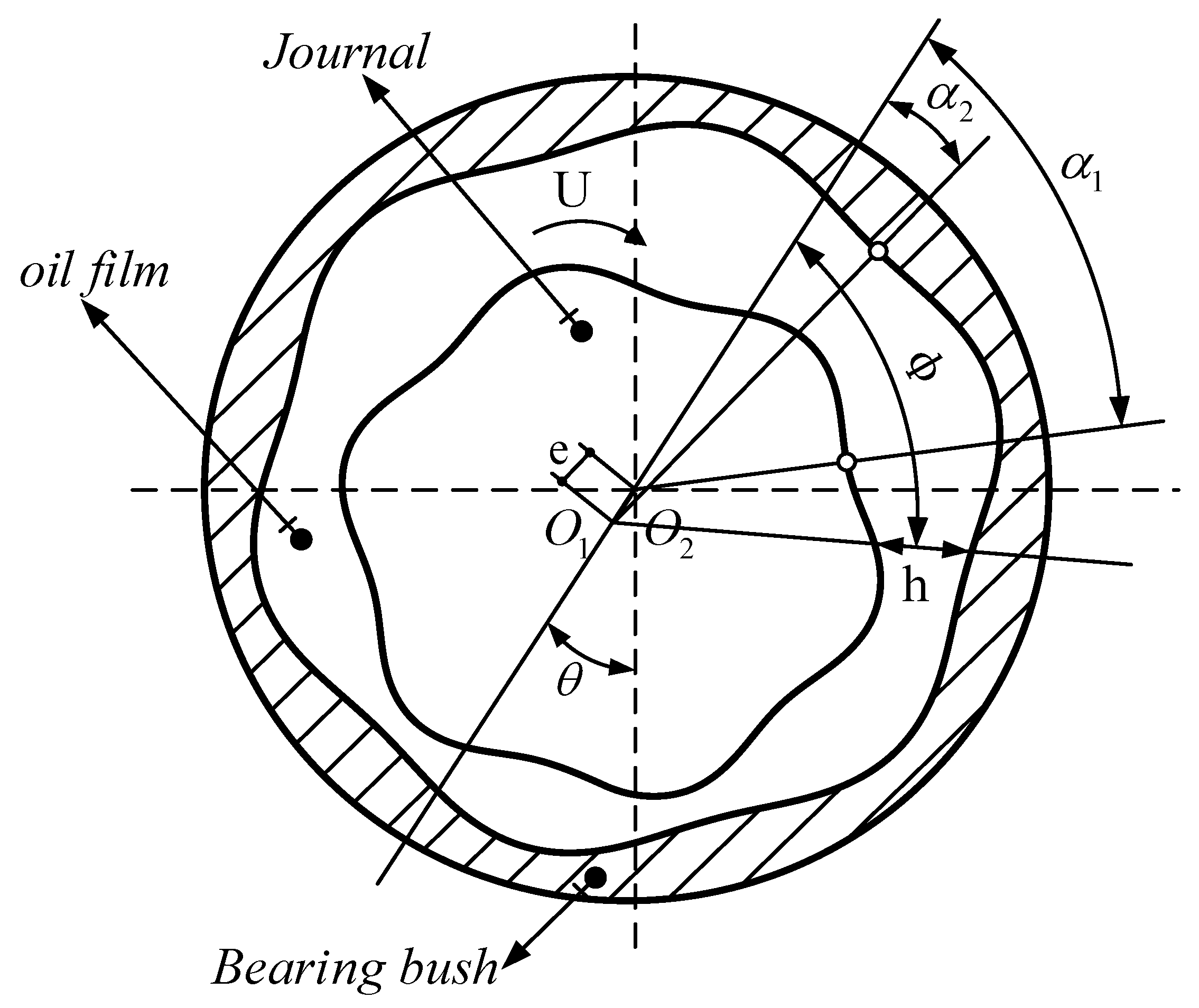
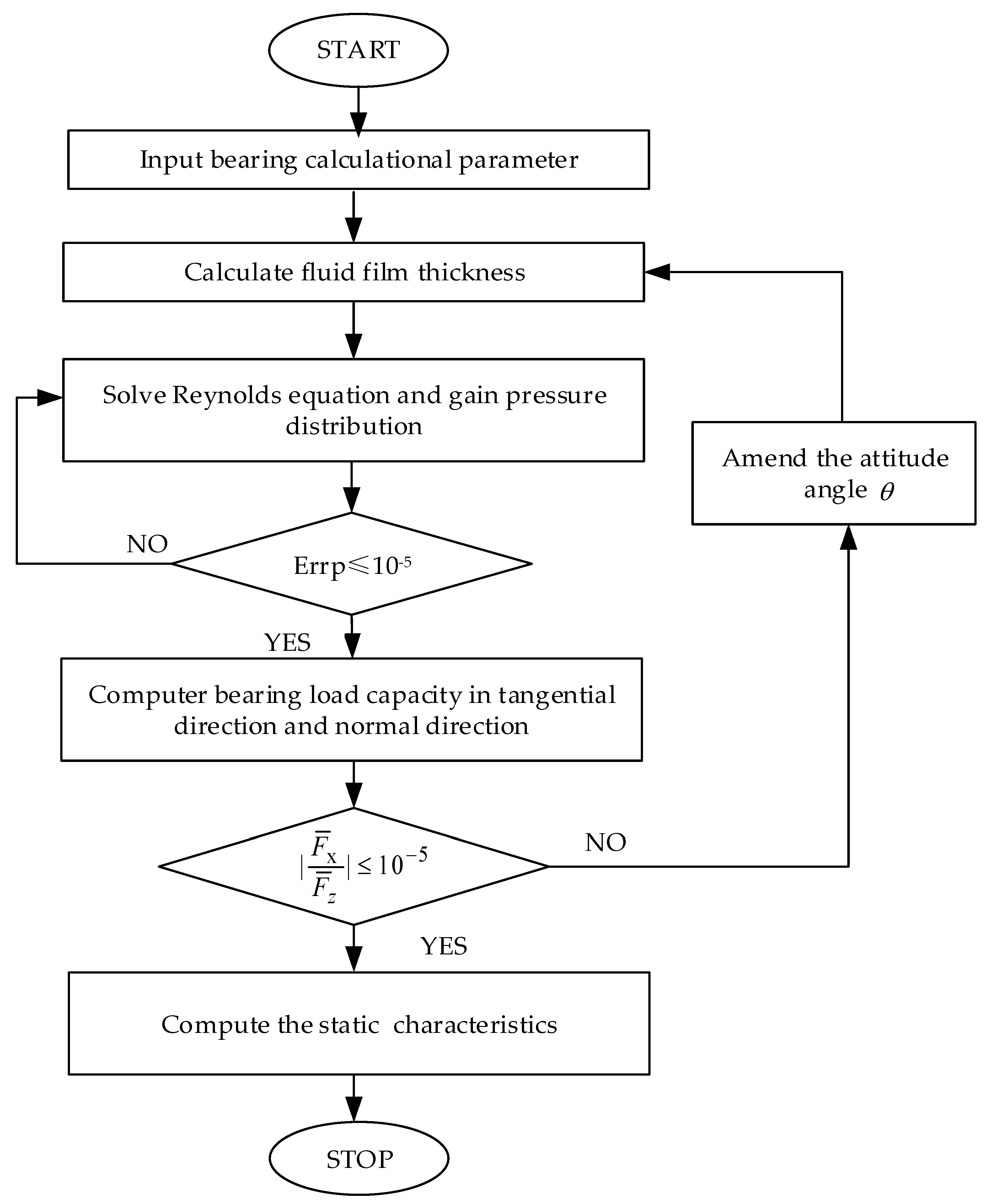

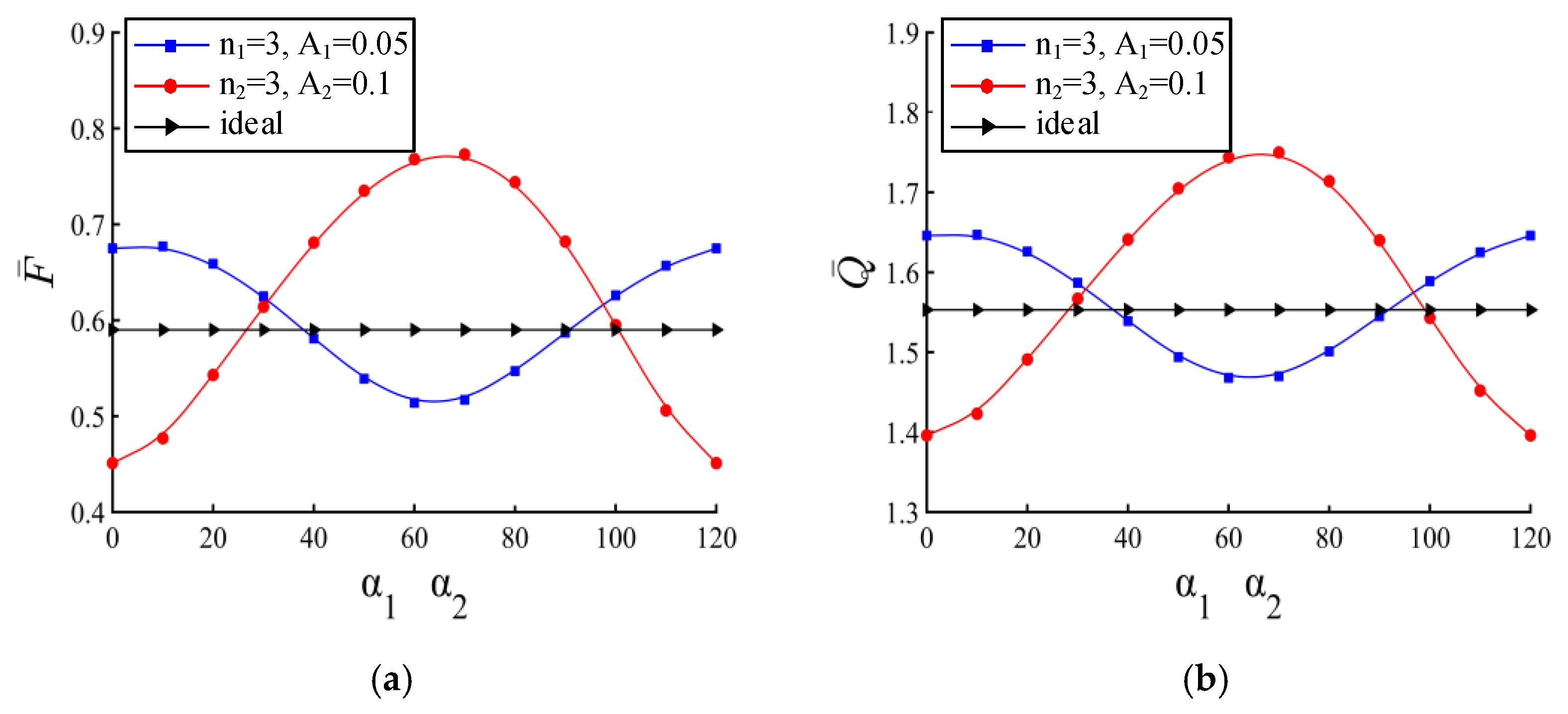

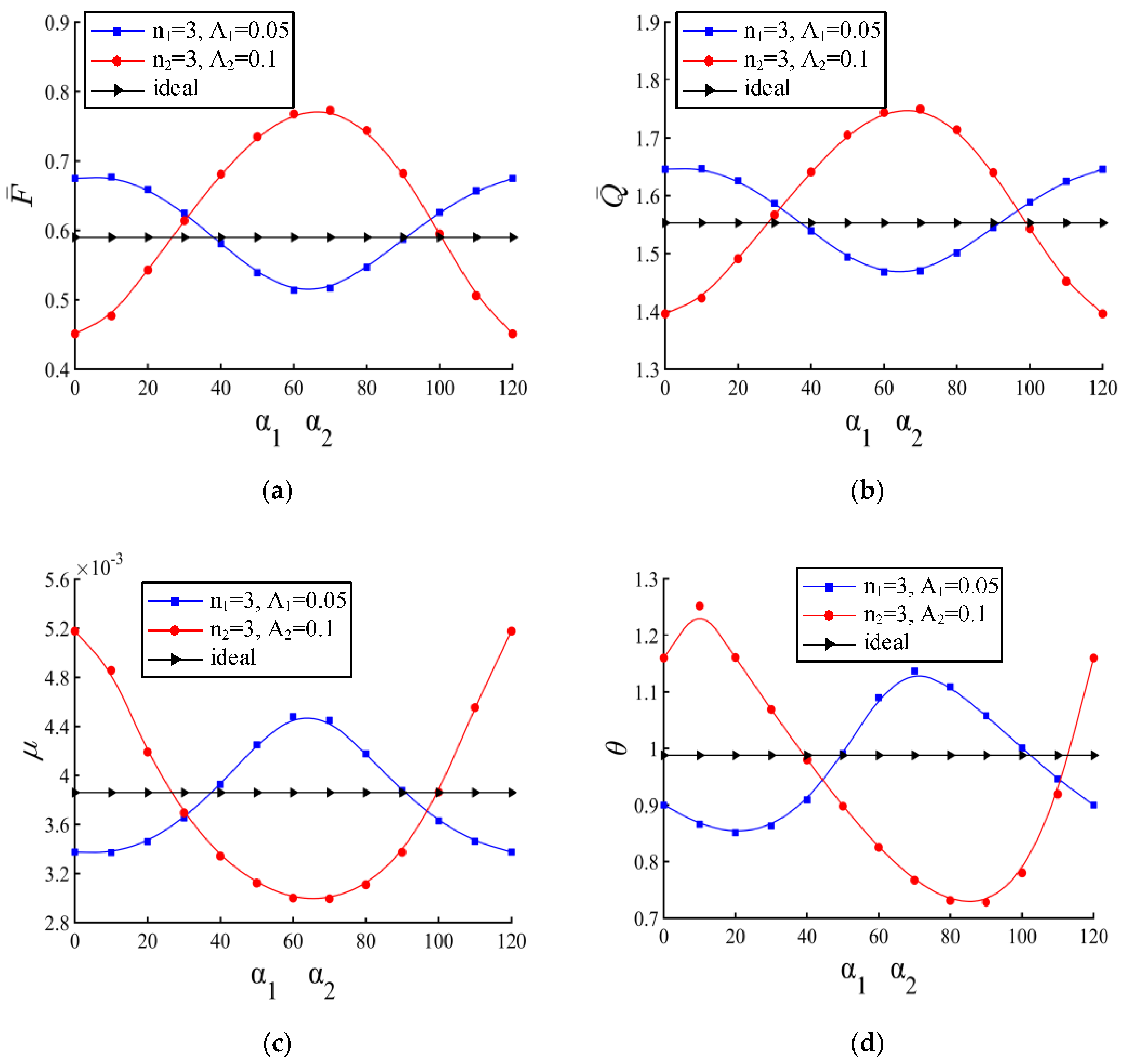


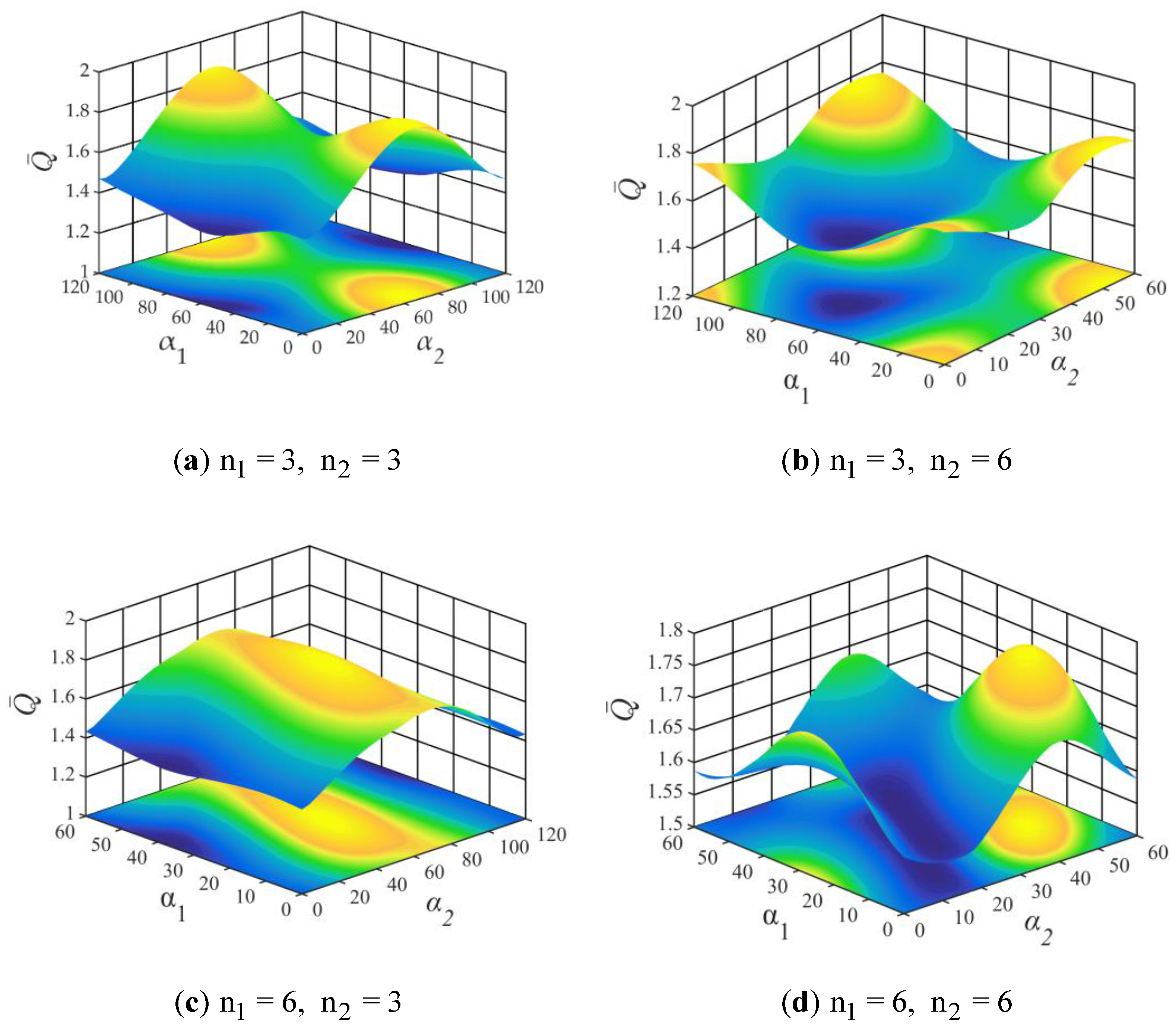
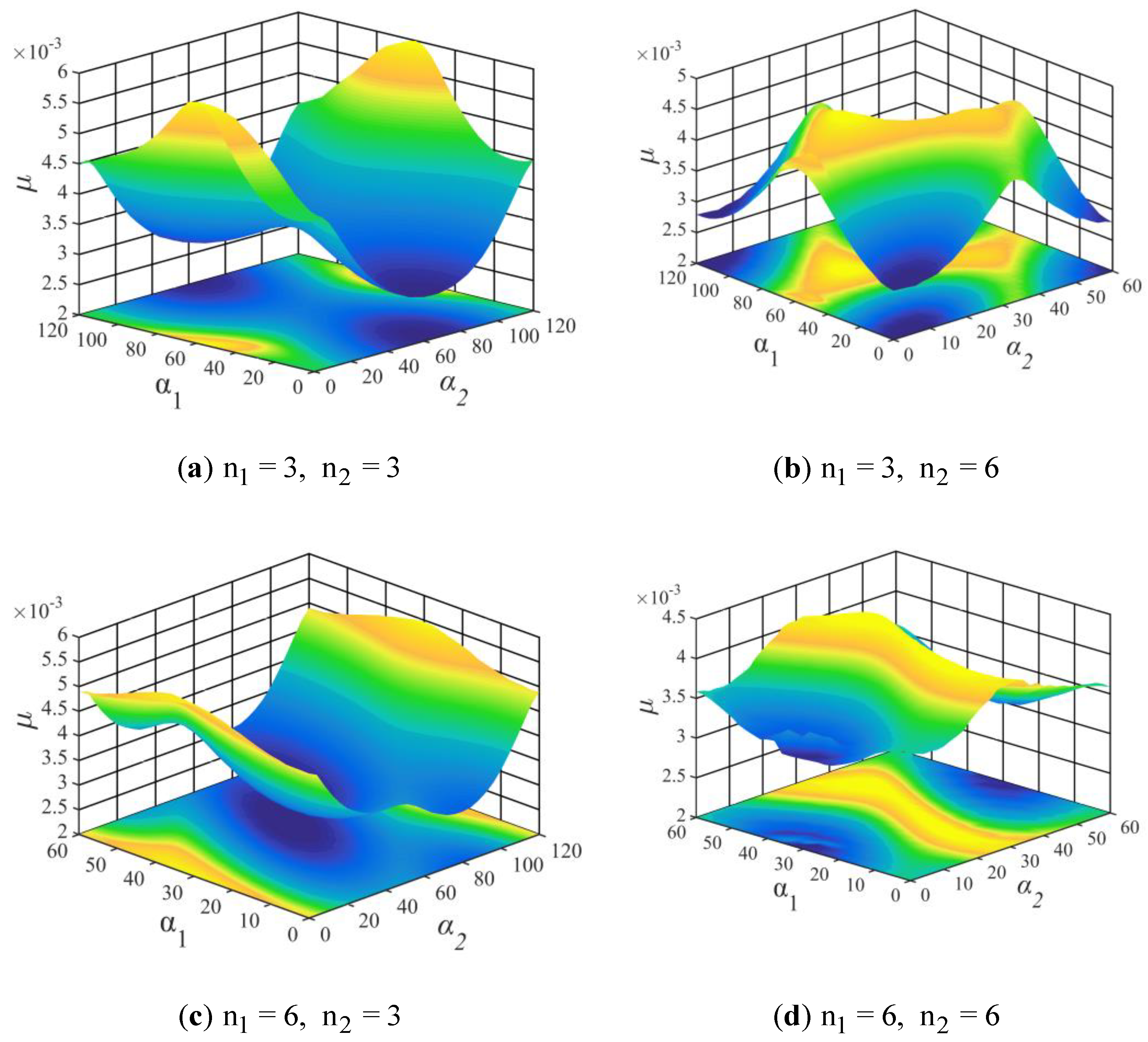
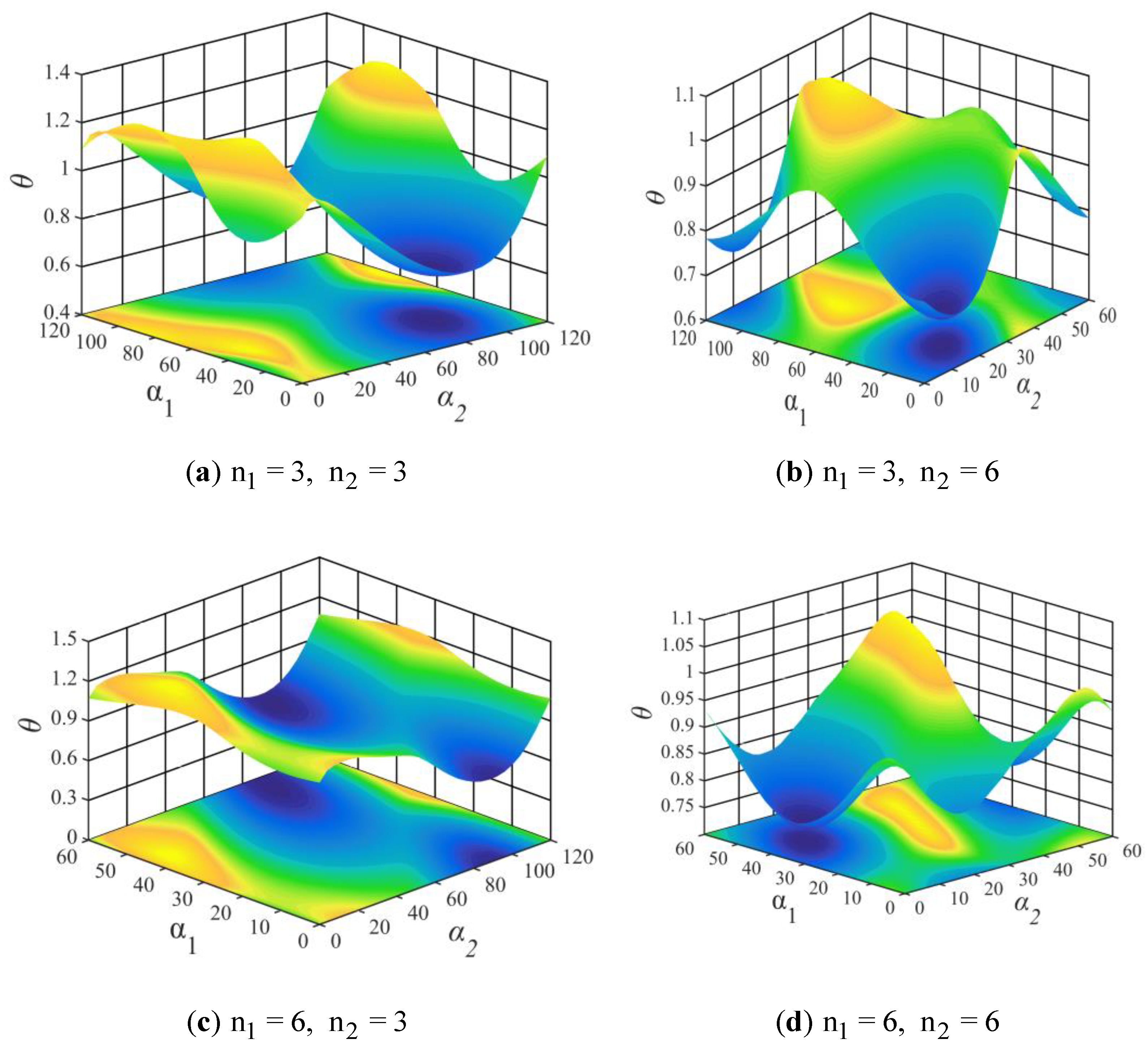
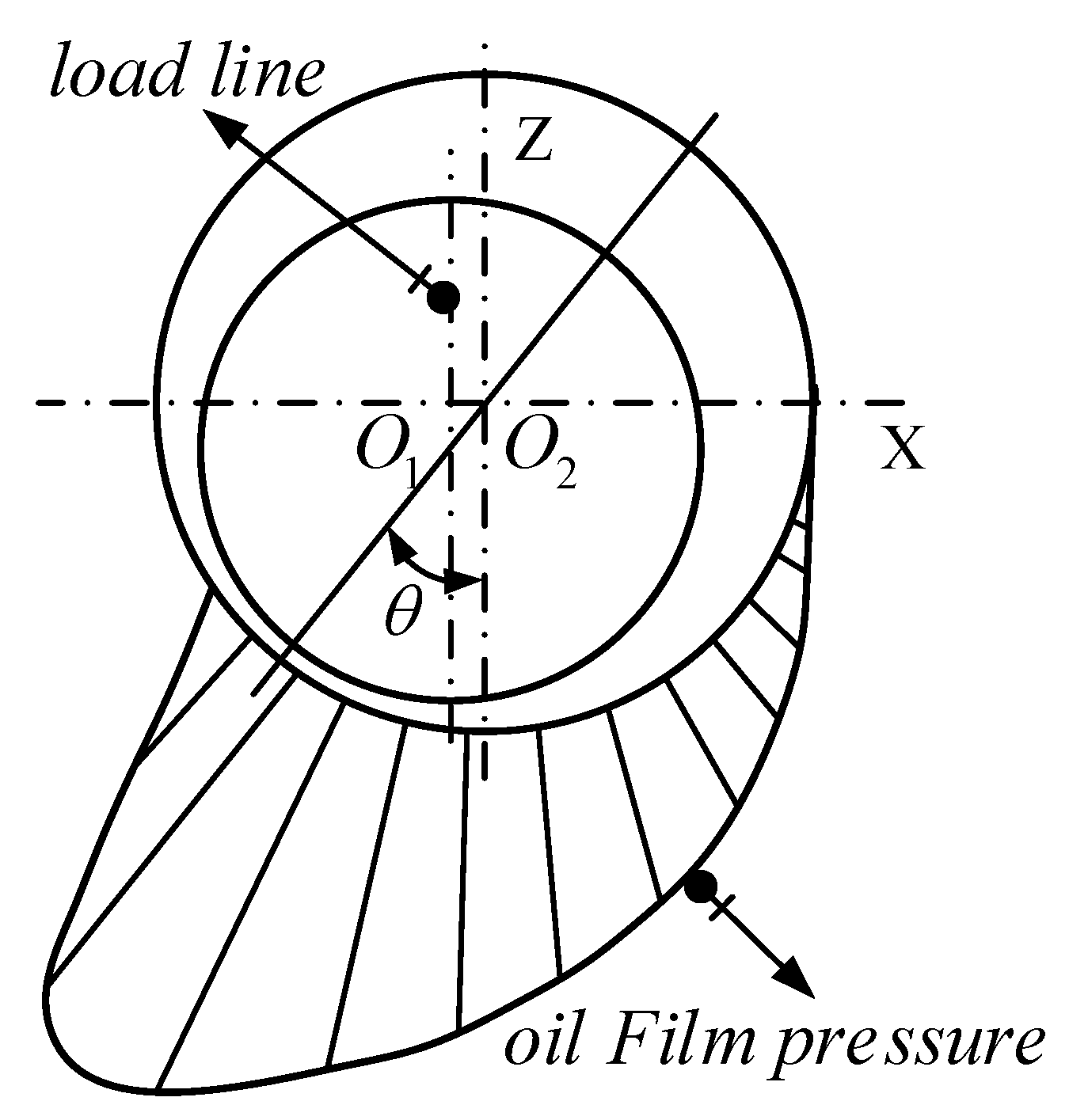
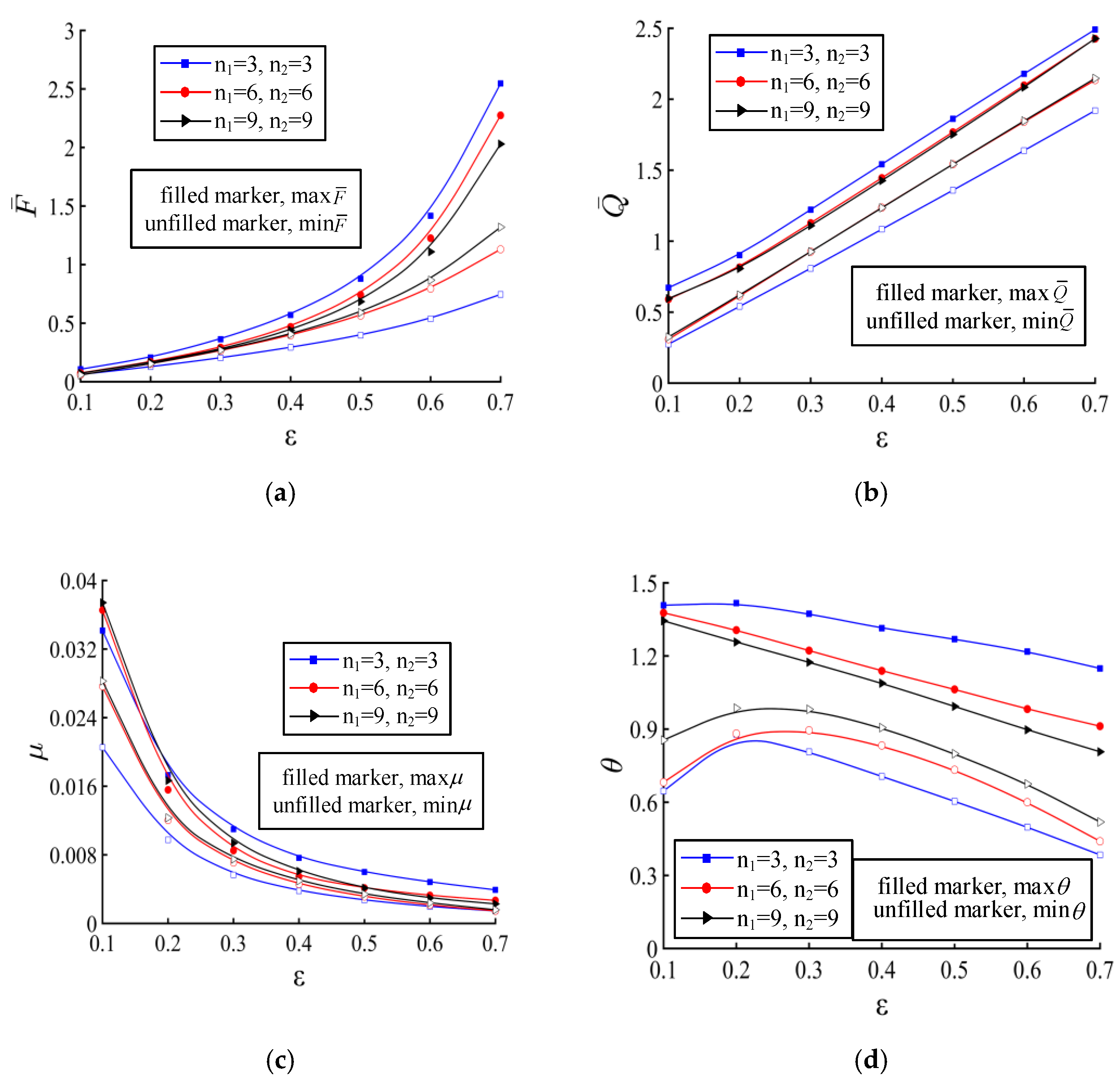
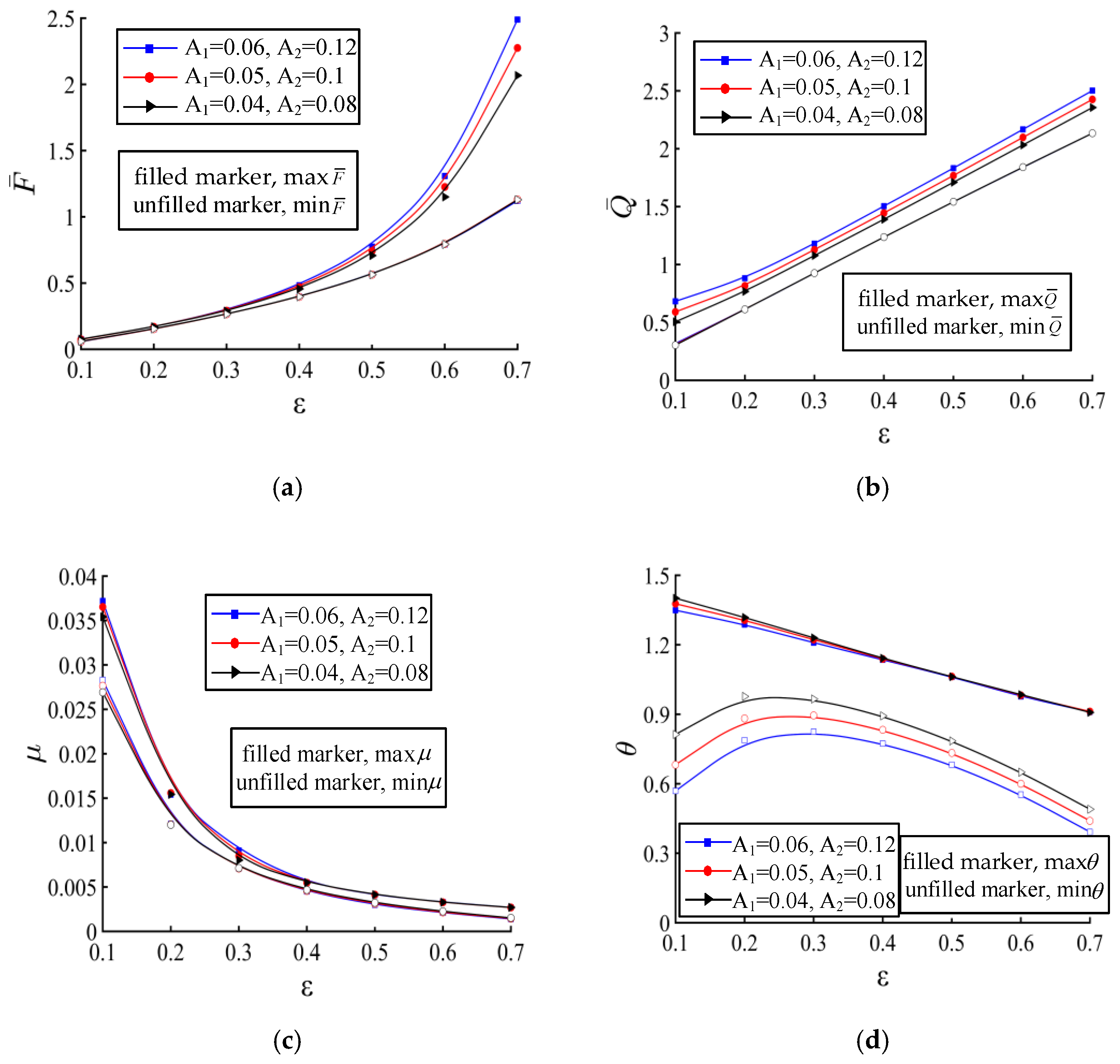
| Parameters. | Value |
|---|---|
| Journal radius | 30 mm |
| Bearing length | 66 mm |
| Radial clearance | 0.03 mm |
| Rotational speed | 3000 r/min |
| Lubricant viscosity | 0.009 pa s |
| Parameters | Value |
|---|---|
| r: Journal radius | 30 mm |
| : Bearing length | 60 mm |
| : Radial clearance | 0.03 mm |
| : Rotational speed | 3000 r/min |
| : Lubricant viscosity | 0.0125 pa s |
| : Waviness number of journal | 3, 6, 9 |
| : Waviness number of bearing bush | 3, 6, 9 |
| : Waviness amplitude of journal | (1.2, 1.5, 1.8) μm |
| : Waviness amplitude ratio of journal () | 0.04, 0.05, 0.06 |
| : Waviness amplitude of bearing bush | (2.4, 3.0, 3.6) μm |
| : Waviness amplitude ratio of bearing bush () | 0.08, 0.1, 0.12 |
| : Waviness phase angle of journal | |
| : Waviness phase angle of bearing bush |
Publisher’s Note: MDPI stays neutral with regard to jurisdictional claims in published maps and institutional affiliations. |
© 2021 by the authors. Licensee MDPI, Basel, Switzerland. This article is an open access article distributed under the terms and conditions of the Creative Commons Attribution (CC BY) license (http://creativecommons.org/licenses/by/4.0/).
Share and Cite
Yang, M.; Lu, H.; Zhang, X.; Duan, M.; Bao, L.; Wang, B.; Wu, W. Influence of Surface Waviness of Journal and Bearing Bush on the Static Characteristics of Hydrodynamic Bearing. Processes 2021, 9, 110. https://doi.org/10.3390/pr9010110
Yang M, Lu H, Zhang X, Duan M, Bao L, Wang B, Wu W. Influence of Surface Waviness of Journal and Bearing Bush on the Static Characteristics of Hydrodynamic Bearing. Processes. 2021; 9(1):110. https://doi.org/10.3390/pr9010110
Chicago/Turabian StyleYang, Minghui, Hong Lu, Xinbao Zhang, Meng Duan, Liu Bao, Bowen Wang, and Wan Wu. 2021. "Influence of Surface Waviness of Journal and Bearing Bush on the Static Characteristics of Hydrodynamic Bearing" Processes 9, no. 1: 110. https://doi.org/10.3390/pr9010110
APA StyleYang, M., Lu, H., Zhang, X., Duan, M., Bao, L., Wang, B., & Wu, W. (2021). Influence of Surface Waviness of Journal and Bearing Bush on the Static Characteristics of Hydrodynamic Bearing. Processes, 9(1), 110. https://doi.org/10.3390/pr9010110





